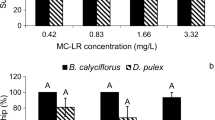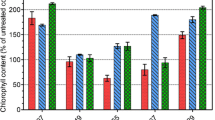Abstract
Mycosporine-like amino-acids (MAAs) are found in aquatic bacteria, algae, and animals. A related compound, the mycosporine-glutaminol-glucoside (myc-glu-glu), has recently been reported in freshwater yeasts. Although animals depend on other organisms as their source of MAAs, they can efficiently accumulate them in their tissues. In this work we assessed the potential transfer of the yeast mycosporine myc-glu-glu from the diet into the copepod Boeckella antiqua and the ciliate Paramecium bursaria. For this purpose, we performed experiments to study the feeding of B. antiqua and P. bursaria on the yeast Rhodotorula minuta and their ability to bioaccumulate myc-glu-glu. Bioaccumulation of myc-glu-glu in B. antiqua was assessed through long-term factorial experiments manipulating the diet (Chlamydomonas reinhardii and C. reinhardii + yeasts) and radiation exposure (PAR and PAR + UVR). Shorter term experiments were designed in the case of P. bursaria. The composition and concentration of MAAs in the diet and in the consumers were determined by HPLC analyses. Our results showed that even though both consumers ingested yeast cells, they were unable to accumulate myc-glu-glu. Moreover, when exposed to conditions that stimulated the accumulation of photoprotective compounds (i.e. UVR exposure), an increase in MAAs concentration occurred in copepods fed C. reinhardii plus yeasts as well as in those fed only C. reinhardii. This suggests that the copepods were able to modify their tissue concentrations of MAAs in response to environmental clues but also that the contribution of yeast mycosporines to total MAAs concentration was negligible.
Similar content being viewed by others
References
J. M. Shick and W. C. Dunlap, Mycosporine-like amino acids and related gadusols: Biosynthesis, Accumulation, and UV-Protective Functions in Aquatic Organisms, Annu. Rev. Physiol., 2002, 64, 223–262.
D. Karentz, Chemical defenses of marine organisms against solar radiation exposure: UV absorbing mycosporine-like amino acids and scytonemin, in Marine Chemical Ecology, ed. J. B. McClintock and B. J. Baker, CRC Press Inc, 2001 Corporate Blvd NW/Boca Raton/FL 33431/USA, 2001, 481–520.
D. Libkind, P. A. Perez, R. Sommaruga, M. C. Diéguez, M. Ferraro, S. Brizzio, H. Zagarese and M. R. Rosa Giraudo, Constitutive and UV-inducible synthesis of photoprotective compounds (carotenoids and mycosporines) by freshwater yeasts., Photochem. Photobiol. Sci., 2004, 3, 281–286.
A. T. Banaszak, Photoprotective physiological and biochemical responses of aquatic organisms, in UV effects in aquatic organisms and ecosystems, ed. W. E. Helbling and H. E. Zagarese, The Royal Society of Chemistry, Cambridge, UK, 2003, 329–356.
F. R. Conde, M. S. Churio and C. M. Previtali, The photoprotector mechanism of mycosporine-like amino acids. Excited-state properties and photostability of porphyra-334 in aqueous solution, J. Photochem. Photobiol., 2000, 56, 139–144.
C. M. Leach, Ultraviolet absorbing substances associated with light-induced sporulation in fungi, Can. J. Bot., 1965, 43, 185–200.
E. J. Trione, C. M. Leach and J. M. Mutch, Sporogenic substances isolated from fungi, Nature, 1966, 212, 163–164.
W. M. Bandaranayake, Mycosporines: are they nature’s sunscreens?, Nat. Prod. Rep., 1998, 15, 159–172.
R. Sommaruga, F. Garcia Pichel, UV-absorbing mycosporine-like compounds in planktonic and benthic organisms from a high-mountain lake, Arch. Hydrobiol., 1999, 144, 255–269.
B. Tartarotti, I. Laurion and R. Sommaruga, Large variability in the concentration of mycosporine-like amino acids among zooplankton from lakes located across an altitude gradient, Limnol. Oceanogr., 2001, 46, 1546–1552.
B. Tartarotti, G. Baffico, P. Temporetti and H. E. Zagarese, Mycosporine-like amino acids in planktonic organisms living under different UV exposure conditions in Patagonian lakes, J. Plankton Res., 2004, 26, 753–762.
R. Sommaruga, D. Libkind, M. van Broock and K. Whitehead, Mycosporine-glutaminol-glucoside, a UV-absorbing compound of two Rhodotorula yeast species, Yeast, 2004, 12, 1077–1081.
D. Libkind, R. Sommaruga, H. Zagarese, M. R. van Broock, Mycosporines in carotenogenic yeasts, Syst. Appl. Microbiol., 2005, 28, 749–754.
D. Libkind, S. Brizzio, A. Ruffini, M. Gadanho, M. R. van Broock and J. P. Sampaio, Molecular characterization of carotenogenic yeasts from aquatic environments in Patagonia, Argentina, Antonie Leeuwenhoek, 2003, 84, 313–322.
S. Brizzio, M. van Broock, Characterization of wild yeast killer from Nahuel Huapi National Park (Patagonia, Argentina), J. Food Technol. Biotechnol., 1998, 4, 273–278.
H. E. Zagarese, M. Feldman and C. E. Williamson, UV-B induced damage and photoreactivation in three species of Boeckella (Copepoda, Calanoida), J. Plankton Res., 1997, 19, 357–367.
H. Utermöhl, Zur Vervollkommung der quantitativen phytoplankton-methodik, Mitt Int. Ver. Limnol., 1958, 9, 1–38.
I. Laurion, M. Ventura, J. Catalan, R. Psenner and R. Sommaruga, Attenuation of ultraviolet radiation in mountain lakes: Factors controlling the among- and within-lake variability, Limnol. Oceanogr., 2000, 45, 1274–1288.
M. L. Bouillant, J. L. Pittet, J. Bernillon, J. Favre-Bonvin and N. Arpin, Mycosporines from Ascochyta pisi, Cladosporium herbarum and Septoria nodorum, , Phytochemistry, 1981, 20, 2705–2707.
B. Tartarotti and R. Sommaruga, The effect of different methanol concentrations and temperatures on the extraction of mycosporine-like amino acids (MAAs) in algae and zooplankton, Arch. Hydrobiol., 2000, 154, 4, 691–703.
R. E. Moeller, S. Gilroy, C. E. Williamson, G. Grad and R. Sommaruga, Dietary acquisition of photoprotective compounds (mycosporine-like amino acids, carotenoids) and acclimation to ultraviolet radiation in a freshwater copepod, Limnol. Oceanogr, 2005, 50(2), 427–439.
R. D. Allen and L. A. Staehelin, Digestive systems membranes: freeze-fracture evidence for differentiation and flow in Paramecium, J. Cell Biol., 1981, 89, 9–20.
M. L. Dionisio-Sese, M. Ishikura, T. Maruyama and S. Miyachi, UV-absorbing substances in the tunic of a colonial ascidian protect its symbiont, Prochloron sp., from damage by UV-B radiation, Mar. Biol., 1997, 128, 455–461.
J. M. Shick, S. RomaineLioud, C. FerrierPages and J. P. Gattuso, Ultraviolet-B radiation stimulates shikimate pathway-dependent accumulation of mycosporine-like amino acids in the coral Stylophora pistillata despite decreases in its population of symbiotic dinoflagellates, Limnol. Oceanogr., 1999, 44, 1667–1682.
A. T. Banaszak and R. K. Trench, Effects of ultraviolet (UV) radiation on marine microalgal-invertebrate symbioses. 2. The synthesis of mycosporine-like amino acids in response to exposure to UV in Anthopleura elegantissima and Cassiopeia xamachana, J. Exp. Mar. Biol. Ecol., 1995, 194, 233–250.
A. T. Banaszak, T. C. LaJeunesse and R. K. Trench, The synthesis of mycosporine-like amino acids (MAAs) by cultured, symbiotic dinoflagellates, J. Exp. Mar. Biol. Ecol., 2000, 249, 219–233.
N. Chang and D. G. Jenkins, Plastid endosymbionts in the freshwater crustacean Daphnia obtuse, J. Crustacean Biol.,, 2000, 20, 231–238.
Author information
Authors and Affiliations
Corresponding author
Rights and permissions
About this article
Cite this article
Pérez, P., Libkind, D., Diéguez, M.d.C. et al. Mycosporines from freshwater yeasts: a trophic cul-de-sac?. Photochem Photobiol Sci 5, 25–30 (2006). https://doi.org/10.1039/b509764a
Received:
Accepted:
Published:
Issue Date:
DOI: https://doi.org/10.1039/b509764a




